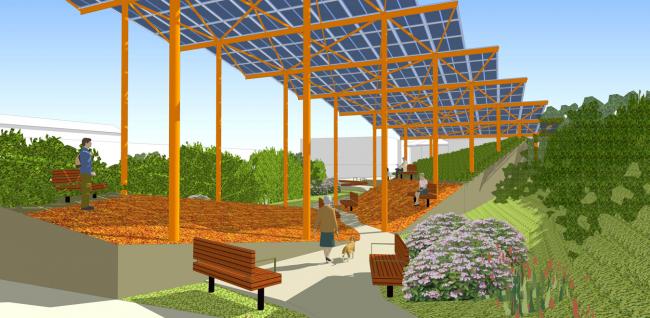Community weighs in on final substation park designs
The Double Wedge, one of two final schemes presented April 20 for the Sunset Hill substation park. CLICK PHOTO TO VIEW MORE IMAGES.
Wed, 04/21/2010
On April 20, CAST Architecture presented the final design, with two alternate schemes, for the solar-generating park members of the community are hoping to build on the City Light-owned substation property behind Ristorante Picolinos on Northwest 65th Street and 32nd Avenue Northwest.
Matt Hutchins from CAST Architecture said the Wedge Scheme from the March 25 meeting was the most popular with meeting attendees and commenters on the project's blog, followed by the Big Roof scheme and the Pair scheme.
The two final schemes are variations on the Wedge, called the Double Wedge Scheme and the Single Wedge Scheme.
The Double Wedge features two hillsides, one in the northeast corner and one in the southwest corner, that create an artificial valley for the path through the middle.
The Single Wedge has a hillside in the northeast corner but a gently sloping lawn at the south end of the site, creating an open meeting area in the middle of the site.
In the Double Wedge scheme, the meeting area would be in the southwest corner where stairs lead down from the alley and create seating.
Both schemes feature an emergency center, an area to see how the solar panels work, a cistern for water runoff and interesting topography, which Hutchins compared to Gas Works Park, that children can bound around on.
Hutchins said CAST created as many sight-lines through the park as possible to increase public safety. The main problem with the original Wedge scheme was its blind spots. The largest blind spot in the current site will come from Ristorante Picolinos new tent, he said.
The new schemes increases the site's solar generating power from 20 kW to 31.3 kW while only covering half the site with solar panels by having a more compact array design, he said.
One meeting attendee said there are too many solar panels in the design, especially in the southwest corner, which is the sunniest area of the site. She said she likes the sun more than solar panels.
Other attendees were also concerned about the southwest corner, where the solar panels, which have a high-point of 30 feet, are only eight feet above the ground.
Hutchins said it is possible the array could be reconfigured, but that is the area of the site where the solar panels would have little chance of being blocked by surrounding development.
He said in order to convince City Light that a solar-generating community park is a viable plan, the solar-generating aspect of it has to be more than window dressing. The more power-generating they do, the more applicable the project is as a prototype for City Light.
Backers of the park are hoping to convince City Light to maintain ownership of the area while letting them build the park to avoid the cost of purchasing the land.
A meeting attendee said he thinks community excitement about the park would be more convincing to City Light than the amount of power being generated.
The most discussed aspect of the schemes was CAST's idea to use artificial turf for the landscaping of the hills and lawns in the park. This would have an upfront cost but require no maintenance or watering, Hutchins said.
The solar panels, while letting in plenty of ambient light, remove 90 percent of the site's direct sunlight, Hutchins said. He said grass that is heavily used for walking, sitting and playing would not be able to regenerate itself.
Forrest Murphy of CAST Architecture said new artificial turfs are nice and soft, like outdoor carpet. The artificial turf could be installed in a bright color, such as orange, so as not to mimic real grass, he said.
Dave Boyd from Groundswell NW encouraged CAST to use hardscape instead of artificial turf in the park's landscaping.
Murphy said they had considered that but thought it might lead to the park being used as a skatepark, which is not their intention.
Robert Drucker from the Sunset Hill Community Association said he is encouraged by CAST's creative thinking on the landscaping of the site. The substation park is not meant to be a typical Seattle park but a prototype for a new kind of park, he said.
Hutchins said the next step is to take the scheme that gets the most people excited and create a feasibility study to be released in June.
Murphy said the study will need to convince the people and organizations with money and power to make the park happen.
Though convincing City Light to maintain ownership of the substation property and let the community build the park is still an uphill battle, Drucker said City Light is guardedly optimistic about community solar power projects.
To weigh in on the project and the final designs, visit www.sunsetsubstation.org.













